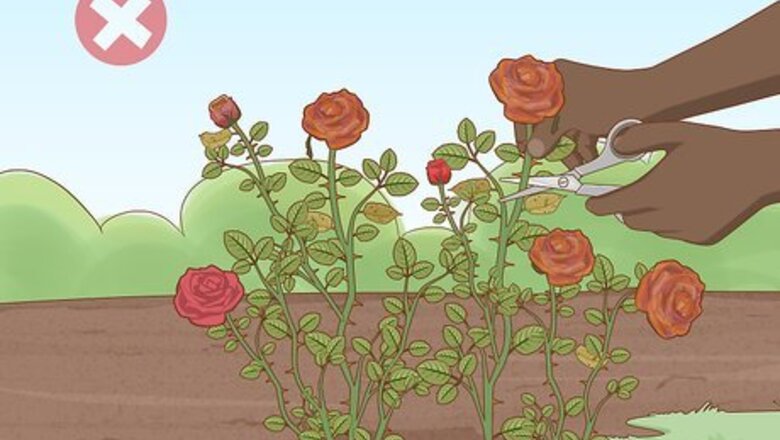
views
Timing Fall Pruning
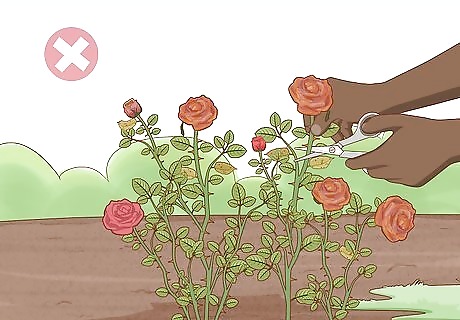
Stop deadheading 8 to 10 weeks before the first frost. Deadheading is the process of removing all of the flowerheads from your rose bush. This is beneficial during the warm weather to promote new growth, but it can damage the plant as the cold weather sets in. Stop deadheading your rose bush about 2 months before the cold sets in. Leaving the flowerheads on the bush protects the ends of the branches from freezing.
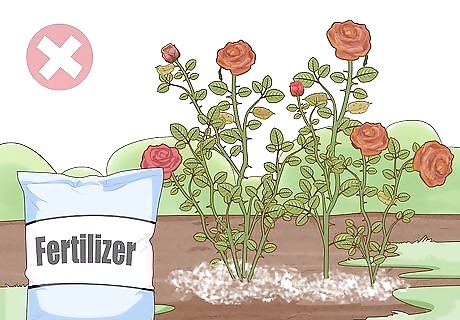
Avoid fertilizing and transplanting as the cold weather sets in. Fertilizing and transplanting your rose bush can promote new growth. This new growth can get damaged in the cold weather and can harm your plant. Try to stop fertilizing and transplanting your rose bush in the late summer. Rose bushes usually do not grow in the cold weather anyway. Plan on fertilizing, transplanting, and promoting new growth on your rose bush in the spring and summer.

Wait until the first frost is over to prune. Pruning your rose bushes can promote new growth. If you trim them before the first frost, it could create new buds that will be killed when the first frost comes along. This can damage the plant and make it produce less flowers in the spring. Wait until your area has had at least 1 frost before you trim your roses. The first frost comes at a different time for every climate. For most temperate areas, it comes around late fall in November or December. If you live in a warmer or colder climate, it could come much sooner or much later.
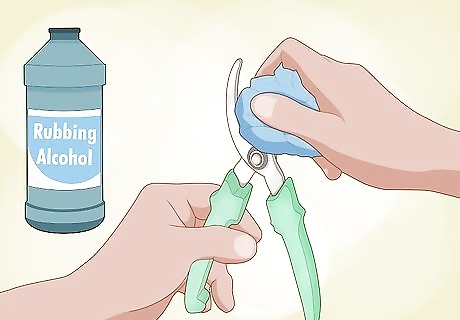
Wipe a pair of sharp pruners with alcohol to sterilize the blades. It is important to use the correct tools when you prune your rose bushes. Get sharp pruners and dip them in isopropyl alcohol to disinfect them before you use them.Warning: If your rose bush has any mildew or fungus, which normally looks like white spots on the branches of the bush, you should sterilize your pruners in between each cut. If it doesn’t, you can use your pruners on multiple bushes without sterilizing them. If your rose bush is big or thick, you can use sharp loppers with long handles to reach into the middle of the bush. Loppers give you less control, so use caution as you make your cuts.
Removing Branches and Canes
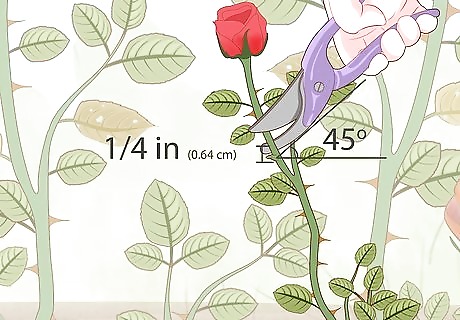
Make each cut at a 45 degree angle above the buds. The buds on your rose bush create new growth. In the fall, they will probably look like small green dots on the branches of your bush. Make your cuts about ⁄4 in (0.64 cm) above the bud at a 45 degree angle to keep the bud for the spring and lessen the damage to the branch. Cutting at a 45 degree angle allows water to run off of the branch and not collect on top of the cut.

Cut off about ⅓ of each branch. Roses are super hearty bushes and they love to be cut down. In the fall, take off about ⅓ of each branch that you cut so your rose bush can grow healthy and tall in the spring. You can cut your rose bush down even more if you’d like to change its shape or height. Make sure to leave at least 6 inches (15 cm) of branches above the ground so that your rose bush can grow back.
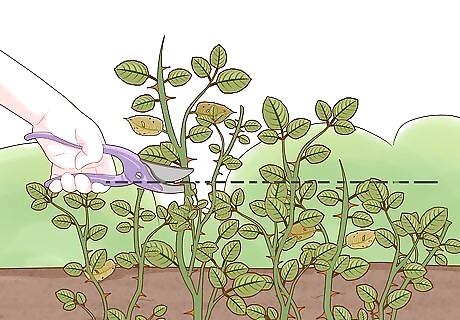
Cut away any heavy top pieces so the bush doesn’t bend when it freezes. Fall is usually a rain-heavy time for most areas. If your rose bush is very top heavy, it could bend and break as the rain collects and freezes on it. If you notice large clumps of branches near the top of your bush, cut those down to size until they are relatively the same height as the rest of the bush. This will also make your rose bush look more uniform.
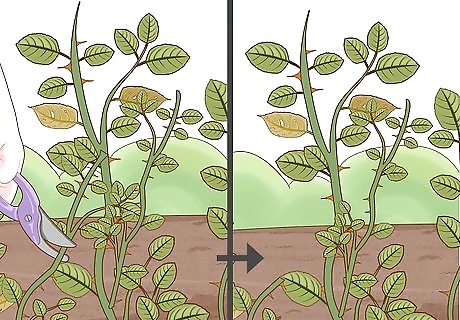
Separate any branches that could rub together. Fall is a wet and windy time, and branches that are too close to each other can create friction and damage your plant. If you notice 2 branches that are crossed over each other, trim at least 1 back so that they aren’t near each other anymore. This can also improve the overall appearance of your rose bush and make it look more full when it starts to flower.
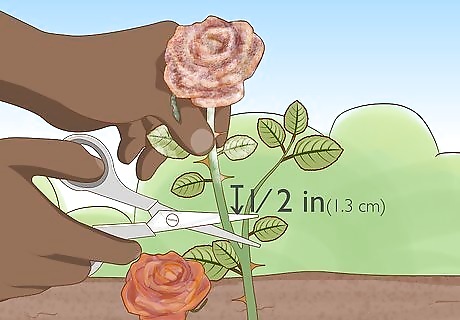
Remove any dead or diseased branches. Branches that are small and skinny or leaves with yellow splotches may indicate a fungal infection in your roses. Cut off the branches about ⁄2 in (1.3 cm) below the diseased area to stop the spread of infection.Warning: Always disinfect your pruning tools after you cut a diseased branch to stop the spread of infection. Spray lysol on your tool or dip it in isopropyl alcohol as soon as you can. An infection on your rose bush doesn’t mean an imminent death. If you cut off the affected branches in the fall, it is much less likely that the infection will spread come springtime.
Trimming Foliage and Mulching
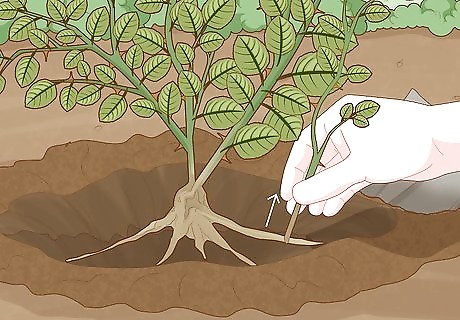
Tear off any suckers at the base of the bush. Suckers are small offshoots of your rose bush that take away energy and food from the main plant. Dig down as far as you can toward the base of the sucker and tear it out of the ground with your hands. You can also use your pruners to cut the suckers back if they are too thick to tear.

Clip off any diseased leaves with your pruners. Never tear or rip the leaves off of the branches of your rose bush, since this could leave openings for diseases. Look for leaves with black, yellow, or white spots and carefully snip them off at the base. Removing the infected leaves before your bush goes into dormancy for the winter increases its chances for survival. If your rose bush has a fungal infection that won’t go away, remove all of the leaves completely and then spray the bush with lime sulfur. This will sanitize the bush and kill the fungus.

Rake up any leaves and fallen branches from the base of the bush. If your rose bush had any fungal infections, leaving the infected branches and leaves on the ground can spread the fungus further. Use a rake to pick up all of the debris from around your bush and dispose of it.Warning: If you noticed any fungal infections on your rose bush, do not put the debris into the compost. This could spread the infection. Instead, put your yard debris into the garbage where it will not be spread to other foliage.

Add a 2 to 3 in (51 to 76 mm) layer of mulch around the base of the bush. Mulch helps to protect the roots of your rose bush from the extremely cold weather that is about to come. Pile a thin layer of either mulch or compost to insulate the roots and keep your rose bush healthy. You can purchase mulch or compost at your local garden supply store, or you can make your own compost at home.



















Comments
0 comment